A PR representative provided Play Critically with a review code for this videogame.
ENDER MAGNOLIA: Bloom in the Mist is a nonlinear platforming RPG set in the Land of Fumes, a nation whose inhabitants combine science and magic to protect themselves from a blighted rainfall. The story begins when a white-haired girl named Lilac awakens in a pod inside a ruined building. She is an attuner, trained to form bonds with Homunculi, an artificial lifeform created to perform every kind of task for the people they serve. With no memory of how she ended up in the pod, Lilac explores the nearby area and discovers another amnesiac, a deadly warrior Homunculus named Nola. Presuming from their shared condition that they also share an origin, the pair decide to team up and explore the three-tiered Strata of the Land of Fumes. Lilac gathers more Homunculi who join Nola in protecting her from Mutants, rogue Homunculi driven to madness by the blighted rainfall, turning the servants on their masters. Together, Lilac and Nola learn why they were discarded into the Lower Strata and the calamitous destiny their portentous abilities have set before them.

More than any of its other elements, ENDER MAGNOLIA is focused on side-scrolling combat with the berserk mutant Homunculi that stalk the Land of Fumes. Lilac is an interesting player character in that she does none of this fighting herself. Instead, she attunes with untainted Homunculi who do all the fighting for her. While she moves through the environments, Lilac appears to be alone, a helpless child lost in a dangerous and hostile world. When I press an action button, a Homunculus bursts from nowhere to unleash its attack against Lilac’s foes, then fades away again. Lilac even recoils when her defender appears, lending a sense of physicality to these ethereal conjurations.
Lilac attunes with up to ten combat Homunculi over the course of her journey. Most join her as part of the plot, often after she defeats them in a boss fight. Only a couple are optional and hidden away, squandering the best potential of the nonlinear platformer. No matter how thoroughly Lilac scours the Land of Fumes for hidden secrets, there is little difference between the Homunculi one player character has available compared to another.
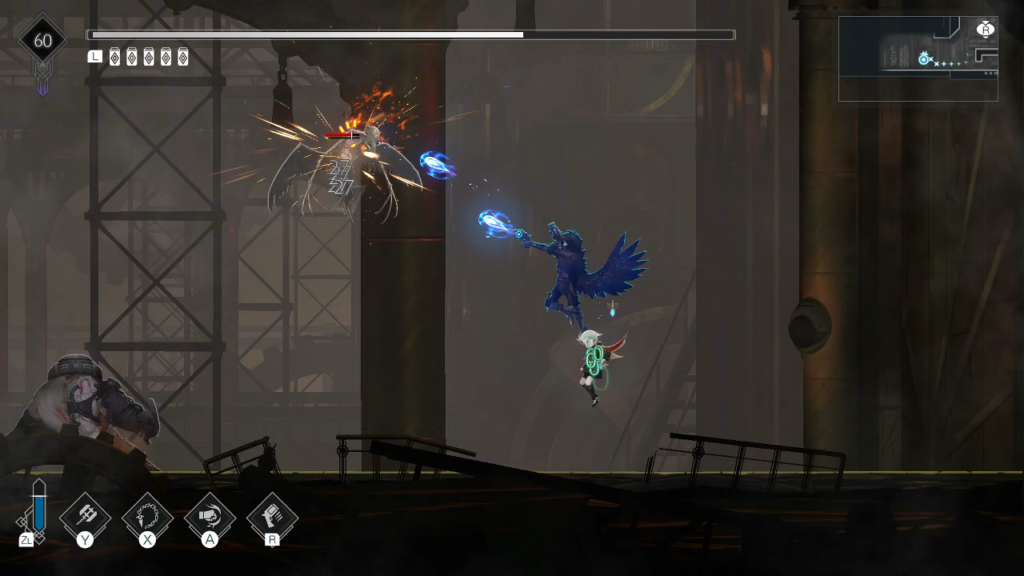
Lilac may attune with just four of her Homunculi at a time, one for each of the non-jumping face buttons and a shoulder button on a standard gamepad. Each Homunculus is assigned a broad category which determines their function. Lito, the Child Test Subject is a Cooldown variety, able to unleash a powerful damaging attack which can burn its target, but Lilac must wait for a short cooldown to expire before he may be used again. Yolvan, the Black-Winged Huntsman is a Pressure attacker. In contrast to Lito’s Cooldown powers, Yolvan produces a stream of weak projectiles from his dual-wielded handguns that automatically tracks nearby enemies for as long as his button is held. There are several more attacking categories besides these and two Homunculi for every category, giving Lilac lots of interesting options.
This choice is further complicated by each Homunculi possessing three different abilities, only one of which may be equipped at a time. Nola is a good example of a Homunculus’ abilities all serving a similar function but often through differing methods. She is a Primary attacker, serving as the main source of damage from Lilac’s Homunculi. When Lilac first attunes with Nola, the warrior is equipped with the Soul Piercer, a sword with average range, attack speed, and damage. As Lilac explores and defeats powerful bosses, Nola learns to wield the Soul Harvester, a scythe with greater range and attack speed, and the Vanquisher, a massive axe with slower attack speed and higher damage. All three choices have advantages and disadvantages and Lilac can only choose one. There are few poor choices among all the Homunculi’s many attacking options, allowing the construction of hundreds of potential offensive loadouts that suit how I want Lilac’s entourage to support her in combat.
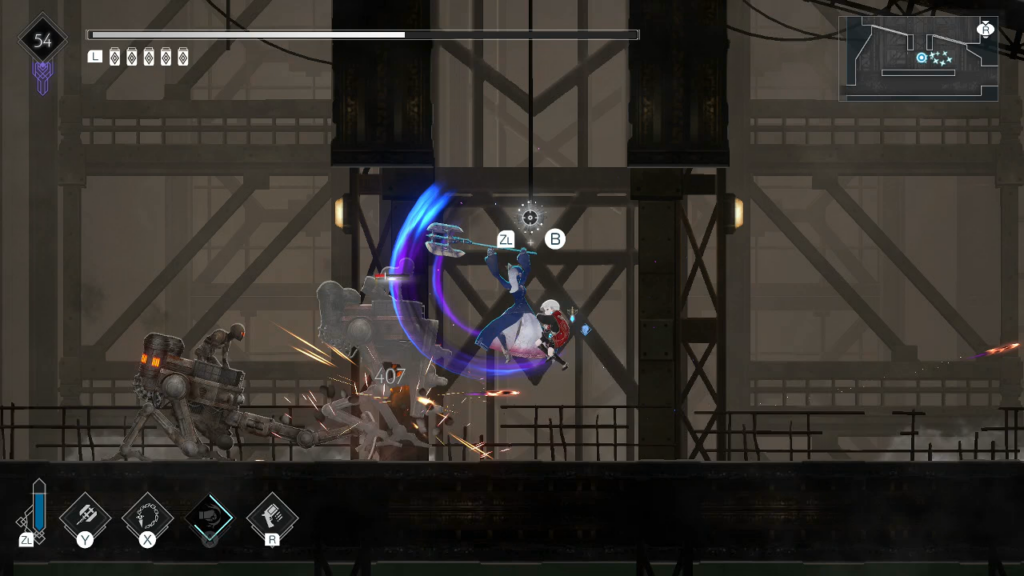
The combat difficulty is average while Lilac and Nola explore the Land of Fume’s Lower Strata. Most standard mutants have predictable attacks that are easy to avoid and don’t deal much damage even when they do connect. The bosses require more ability and concentration but still don’t challenge my skills.
These early enemies are made even easier by one of ENDER MAGNOLIA’s core combat mechanics. Almost every mutant has a yellow stamina meter directly beneath the hit point meter that hovers above their body. Hitting a mutant with attacks from Lilac’s Homunculi drains this meter, with some attacks being more effective at draining it than others. When the meter empties, the mutant is sent flying. Mutants are especially susceptible to fall damage, so if one plummets off an edge or they are one of the many flying mutants that accost Lilac, the impact from their landing is often enough to finish them off. If they survive the knockback, then they are stunned for several more seconds. This is enough time to finish them off. Mutants encountered later are less vulnerable to these tactics but stunning them is still an important part of combat.
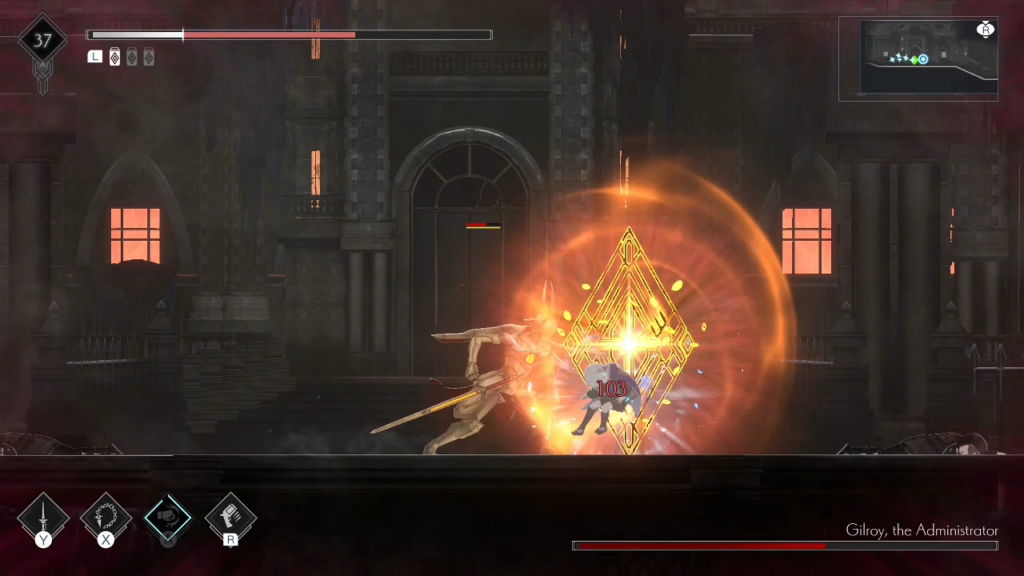
As soon as Lilac gains access to the Middle Strata, ENDER MAGNOLIA hits her with a body blow of a boss fight. It demands perfect responses to every single one of its numerous and rapid attacks. A single mistake is incredibly damaging to Lilac’s health, if not outright fatal. The encounter is a warning of what’s to come in the remainder of the Middle and Upper Stratas. Even standard mutants will send Lilac careening back to the last checkpoint if I make a single mistake in directing her. It’s a spike in difficulty that’s as alarming as it is unexpected.
Mutant’s capabilities for dealing damage in ENDER MAGNOLIA’s latter half are especially humbling because Lilac’s hit point total seems to have little impact on her durability. Even after scouring every inch of the Land of Fumes’ nonlinear platforming environment for hit points upgrades, a single blow from most mutants drains more than half of Lilac’s hit point meter. Healing this damage back feels laborious and at times even futile. Lilac’s Healing Ward has only three charges, takes a moment to use, can be interrupted by mutant attacks, and heals only a small portion of her hit point meter. It takes me a while to determine where I’m going wrong with guiding this delicate player character’s development.
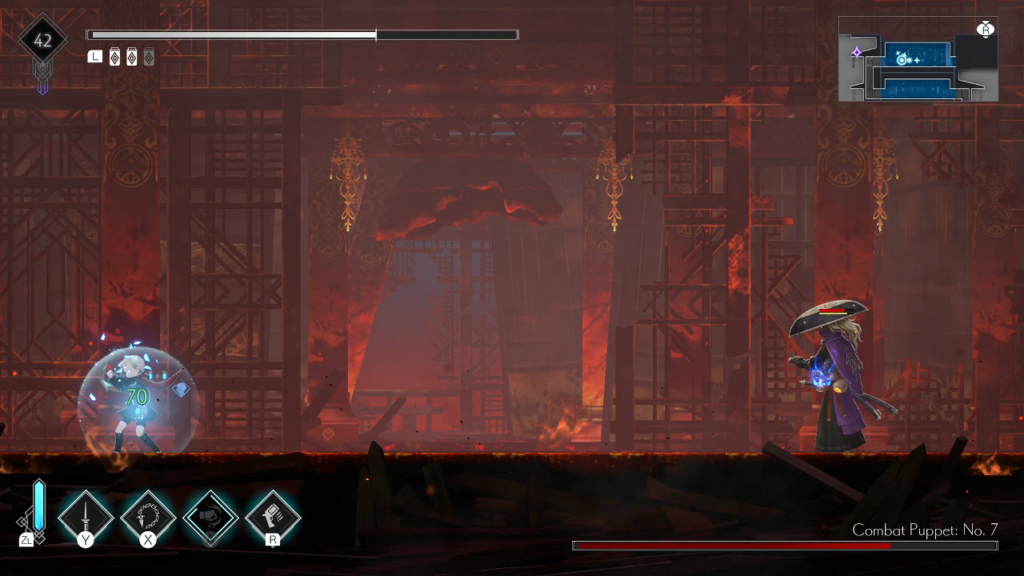
In many other RPGs, the solution to Lilac’s weaknesses would be to find a corner of the world filled with enemies and kill hundreds or even thousands of them to grind experience points and build up experience levels. This solution does not work in ENDER MAGNOLIA. The improvements to Lilac’s statistics from experience levels are minor.
The greater impact to Lilac’s durability comes from the items I choose for her to wear. She has four slots to equip bangles, shells, and totems. Some of these are found hidden around the Land of Fumes. Most are purchased from shops in the Lower and Middle Stratas in exchange for Materials, nebulous scraps of cloth and metal valued by the land’s few human survivors.
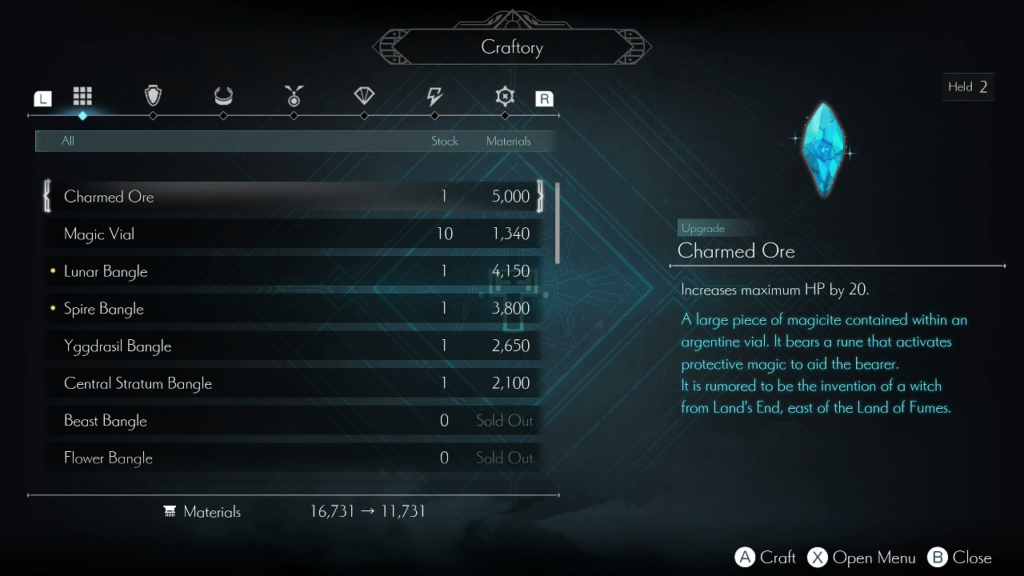
It is my habit in RPGs to focus on equipment that increases the player character’s damage over all other statistics. This is not a successful strategy in ENDER MAGNOLIA, to such an extent that it feels like a trap. Increases to Lilac’s damage are negligible and leave her other statistics at woeful lows. Equipping items that increase defense makes her hit point meter much more durable, giving her space to be much more effective in combat. Equipment with high defense also tends to increase the amount restored by the Healing Ward and also increases its total charges. In any other nonlinear platformer, I expect these improvements to come from hidden collectables. ENDER MAGNOLIA is distinctly focused on what Lilac has purchased to wear from shops.
The other element that impacts Lilac’s statistics are relics. These are much more straightforward than the tradeoffs offered by equipment. They have effects as diverse as boosting Lilac’s attack or defense by flat percentages, offering her immunity to burn, shock, and freezing status effects, enabling passive and active healing effects, and other, even more situational abilities. The amount of relics Lilac may equip is limited by the number of magical vials she possesses. Many of these are found hidden throughout the Land of Fumes, though most are purchased for escalating prices from the same shops that sell equipment. Once again, ENDER MAGNOLIA defies conventions and most of Lilac’s power is purchased instead of discovered.
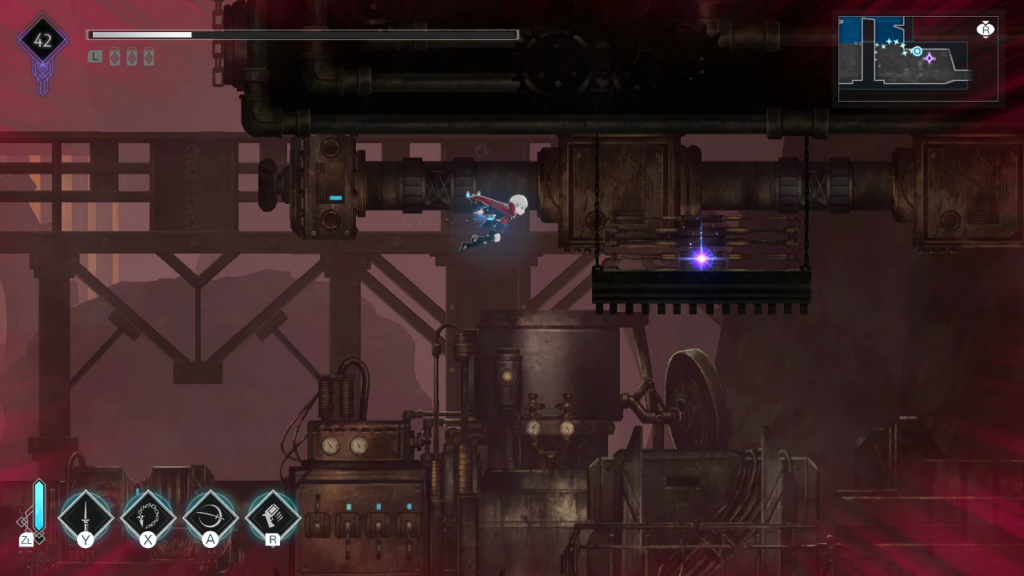
This de-emphasis on collectables is not to suggest that ENDER MAGNOLIA does not have good nonlinear platforming level design. It wastes little time in outfitting Lilac with the cornerstone abilities of an archetypical genre player character: the double jump and the dash. Other staples like wall jumping, a grappling hook, and the power to throw a great weight in all four directions are enabled as Lilac attunes with more of the Homunculi she encounters around the Land of Fumes.
All of these abilities are utilized in clever expressions of skill and unorthodox thinking. Many challenges require Lilac to reach platforms that initially appear beyond her grasp. She may touch down on all of them with creative use of wall jumping and air dashing on apparently decorative sections of geography. Many of the barriers that bar Lilac’s path forward can only be broken by hurling one of her burlier Homunculus allies towards the blocked passage. The place where Lilac must power up this charge can sometimes be found multiple rooms away from the offending barrier. The Land of Fumes is not sprawling or densely interconnected. It is filled with scenarios that exercise and satisfy my platforming skills, many of which cannot be completed until Lilac returns later with a new Homunculus companion.
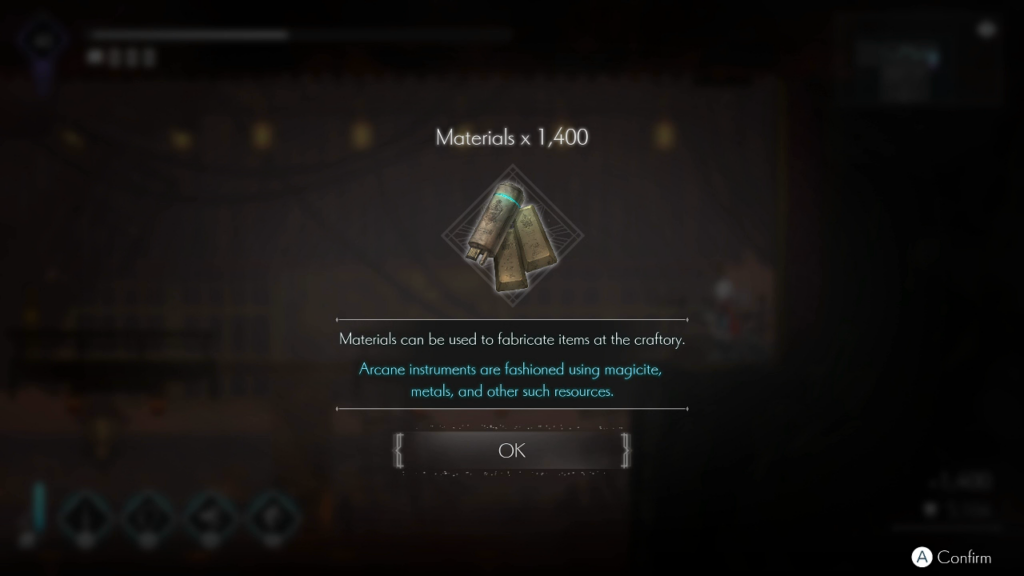
Most of the rewards for completing these challenges disappoint. Since so many of ENDER MAGNOLIA’s best rewards are sold by shops, Lilac’s reward for reaching a collectable or discovering a hidden room is often a stack of the Materials she can spend in those shops. Other items are more uncommon and don’t do much to excite. Crystal shards that increase Lilac’s hit point total provide an improvement of just five more; she begins her adventure with 100, so the upgrade from just one is imperceptible. Lilac has limited slots on which she can wear new equipment and relics, meaning most of what she discovers is immediately put into her inventory and never thought about again. Making the extra effort to gather ENDER MAGNOLIA’s collectables rarely feels impactful to Lilac’s performance.
ENDER MAGNOLIA does, at least, make it easy to tell where the collectables Lilac has yet to find are located. The map of the Land of Fumes depicts each room in greyscale. When Lilac has fully explored a room—found all of its collectables, opened all its doors, and reached all its possible exits—then the grey room changes to blue. This makes it easy to tell at a glance where Lilac still needs to explore. It even goes the extra mile to mark obstacles Lilac lacks the tools to overcome, saving me the time of guiding her to a space with a new ability just to check if she can pass through.

The flaw to this feature is the map may be too helpful. It cuts down on the exploration inherent to nonlinear platforming. Exploration only occurs when Lilac first enters an area and fills in the empty spaces on her map. Any visit to an area after that is just backtracking. Since the benefits to exploration already feel marginalized by the shop-focused rewards systems, this deadens my disappointment with exploration.
Other items Lilac discovers while exploring are documents that fill in the backstory. Since Lilac and Nola both have amnesia, this breadcrumb style of storytelling is necessary to understand how the Land of Fumes came to be in its current condition and how its two heroines were abandoned in the Lower Strata.
While breadcrumb storytelling is already disjointed by its very nature, I found its application in ENDER MAGNOLIA to be especially difficult to follow. Notes Lilac discovers and optional conversations the attuned Homunculi share at checkpoints fill in details about two rival political houses, their work on the Homunculi, exploration of the earth beneath the Lower Strata, and their relationship with the attuners. It’s an unfocused plot filled in retroactively. It has few clear characters, fewer of whom actually appear in the present narrative, and no identifiable conflict. I am eventually able to tease out the relevant information to understand what happens at ENDER MAGNOLIA’s climax. I would enjoy it more if the documents could decide earlier on which details are important and which are the superfluous incidentals of tangential side stories.
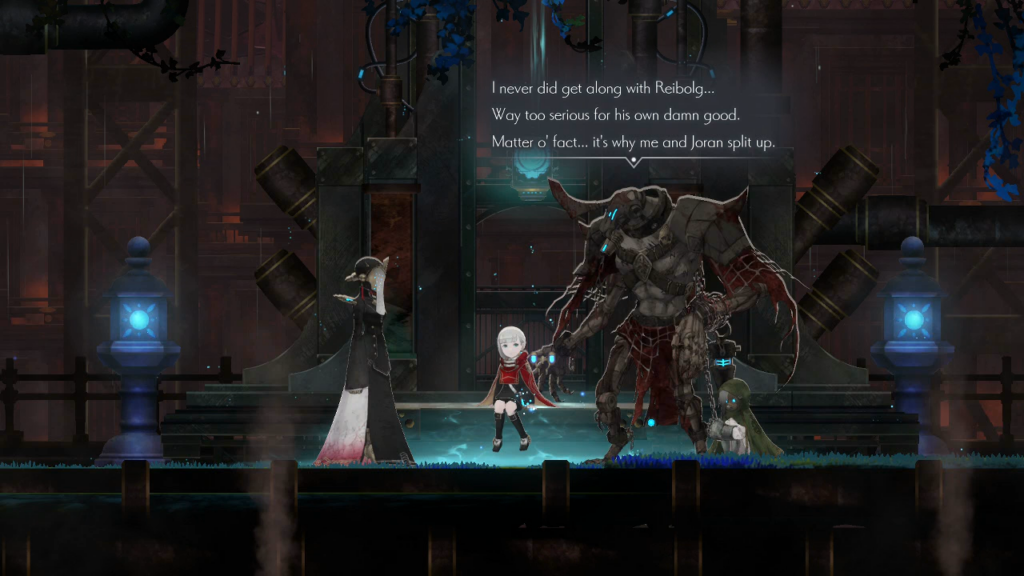
As ENDER MAGNOLIA begins, I recognize its similarities to 2021’s ENDER LILIES: Quietus of the Knights. Both are nonlinear platforming RPGs set in fantasy kingdoms scourged by a blighted rain. Both have white-haired waifs for player characters who are protected by powerful warriors that appear and disappear with the press of a button. Both have an unknown destiny they must unveil which brings salvation to a cursed land plagued by death and destruction. Both videogames even begin at an average difficulty that abruptly increases when the player character reaches a milestone boss fight. If I were being lazy, I could cut and paste parts of my ENDER LILIES review into this one and its broad details would be mostly accurate. But videogames are not about broad details, they are about finer ones, and in its finer points, ENDER MAGNOLIA is a quite different experience.
The most notable differences are Lilac’s Homunculi. They are much fewer in number than the Spirits Lily allies herself with in ENDER LILIES, even if they serve much the same function. They are able to be this streamlined because they individually have far more utility than Lily’s single-function Spirits. The map is also much more focused and coherent. Where Land’s End has a rambling map with rooms placed apparently at random with little logical relationship to the ones surrounding them, the Land of Fumes is a much more geographically reasoned space. Only the rewards for exploring feel more notably different. With ENDER MAGNOLIA concentrating so many of its items in shops, exploring the Land of Fumes doesn’t feel as beneficial towards the player character’s development as it did in Land’s End. Overall, the effect is that ENDER MAGNOLIA feels like a much more refined videogame than ENDER LILIES, a product of greater experience and resources. This is not to suggest that the earlier videogame does not have a few features in its favor.

As I progress deeper into the Land of Fumes, the documents Lilac discovers and the characters she meets makes it apparent that ENDER MAGNOLIA’s story is set some time after the events of ENDER LILIES. Despite this, ENDER MAGNOLIA is best thought of as a companion to its predecessor and not a direct sequel. There is nothing that happens to Lilac and Nola in the Land of Fumes that requires knowledge about Lily and her Umbral Knight in Land’s End. ENDER MAGNOLIA tells a complete and self-contained narrative and is perfectly enjoyable as its own story. Curious players should feel unafraid to play ENDER MAGNOLIA first, though some of its events are more interesting with some foreknowledge of ENDER LILIES.
ENDER MAGNOLIA is a sleek and refined experience with a heavy emphasis on challenging and satisfying combat. It begins on the easy side, perhaps too much so, which makes the sudden spike when Lilac and Nola reach the Middle Strata an upsetting surprise. I am concerned some players may be so disturbed by it that they will play no further. I found muscling through this speed bump to be immensely rewarding as I became more adept at navigating enemies’ intricate combat patterns and gained a greater understanding of the RPG mechanics.
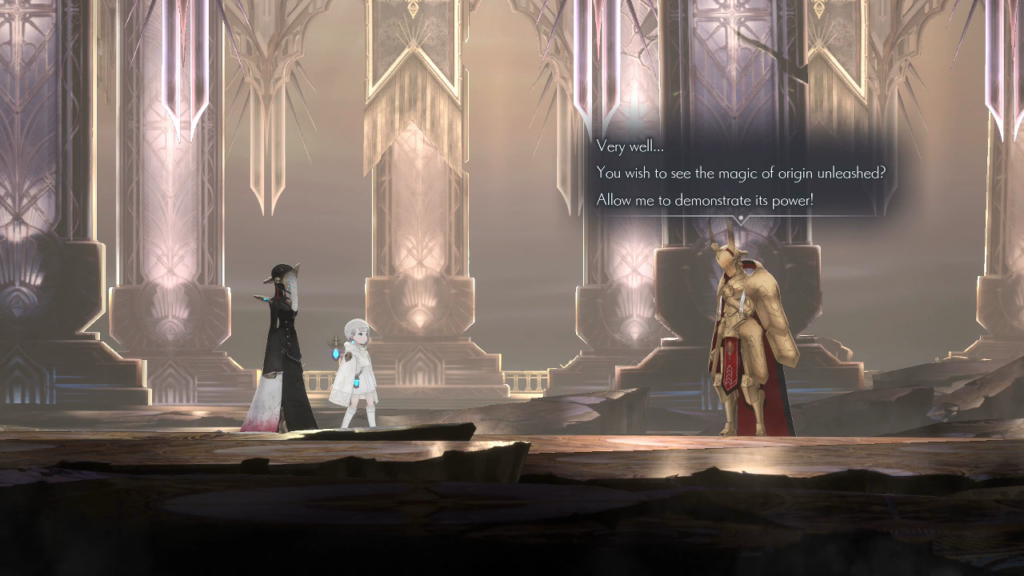
As a nonlinear platformer is where ENDER MAGNOLIA disappoints by comparison. Too many collectables are concentrated in shops, forcing the world to be filled with currency pickups to purchase them. It makes exploration feel unlike a slow and rewarding development of the player character, their strength growing commensurate with their map completion, and more like grinding cash drops to buy the latest toy available in the store. This does not preclude the world being filled with interesting and challenging platforming obstacles. It’s a satisfying platformer, despite feeling a bit lacking in its nonlinear aspects.